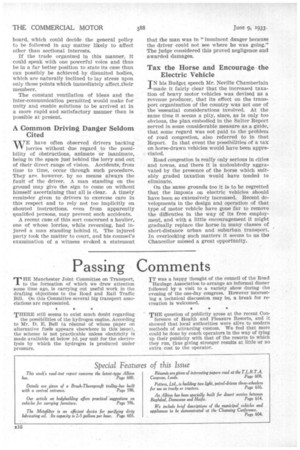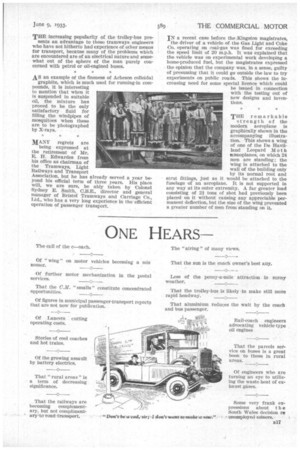Passing Comments
Page 30

Page 31

If you've noticed an error in this article please click here to report it so we can fix it.
rr HE Manchester Joint Committee on Transport, to the formation of which we drew attention some time ago, is carrying out useful work in the drafting objections to the Road and Rail Traffic Bill. On this Committee several big transport associations are represented.
THERE still seems to exist much doubt regarding the possibilities of the hydrogen engine. According to Mr. D. E. Bell (a re.surn6 of whose paper on alternative fuels appears elsewhere in this issue), the scheme is not practicable unless electricity is made available at below id. per unit for the electrolysis by which the hydrogen is produced under pressure. IT was a happy thought of the council of the Road Haulage Association to arrange an informal dinner followed by a visit to a variety show during the evening of the one-clay congress. However interesting a technical discussion may be, a break for recreation is welcomed.
THE question of publicity arose at the recent Con ference of Health and Pleasure Resorts, and it showed that local authorities were alive to modern methods of attracting custom. We feel that more could be clone by coach operators in the way of tying up their publicity with that of the resorts to which they run, thus giving stronger results at little or no extra cost to the operator.
THE increasing popularity of the trolley-bus pre
sents an advantage to those tramways engineers who have not hitherto had experience of other means for transport, because many of the problems which are encountered are of an electrical nature and somewhat out of the sphere of the man purely concerned with petrol or oil-engined buses.
AS an example of the fineness of Acheson colloidal graphite, which is much used for running-in compounds, it is interesting to mention that when it is suspended in suitable oil, the mixture has proved to be the only satisfactory fluid for filling the windpipes of mosquitoes when these are to be photographed by X-rays.
MANY regrets are being expressed at the retirement of Mr. E. H. Edwardes from his office as chairman of the Tramways, Light Railways and Transport Association, but he has already served a year beyond his official term of three years. His place will, we are sure, be ably taken by Colonel Sydney E. Smith, C.B.E., director and general manager of Bristol Tramways and Carriage Co., Ltd., who has a very long experience in the efficient operation of passenger transport. IN a recent case before the.Kiagston magistrates, the driver of a vehicle of the Gas Light and Coke Co. operating on coal-gas was fined for exceeding the speed limit of 20 m.p.h. It was explained that the vehicle was on experimental work developing a home-produced fuel, but the magistrates expressed the opinion that the company was, in a sense, guilty of presuming that it could go outside the law to try experiments on public roads. This shows the increasing need for some special licence which could be issued in connection with the testing out of new designs and inven tions.
THE remarkable
strength of the modern aeroplane is graphically shown in the accompanying illustration. This shows a wing of one of the De Havilland Leopard Moth monoplanes, on which 24 men are standing ; the wing is attached to the wall of the building only by its normal root and strut fittings, just as it would be attached to the fuselage of an aeroplane. It is not supported in any way at its outer extremity. A far greater load consisting of 24 tons of shot had previously been placed on it without causing any appreciable permanent deflection, but the size of the wing prevented a greater number of men from standing on it.




























































































